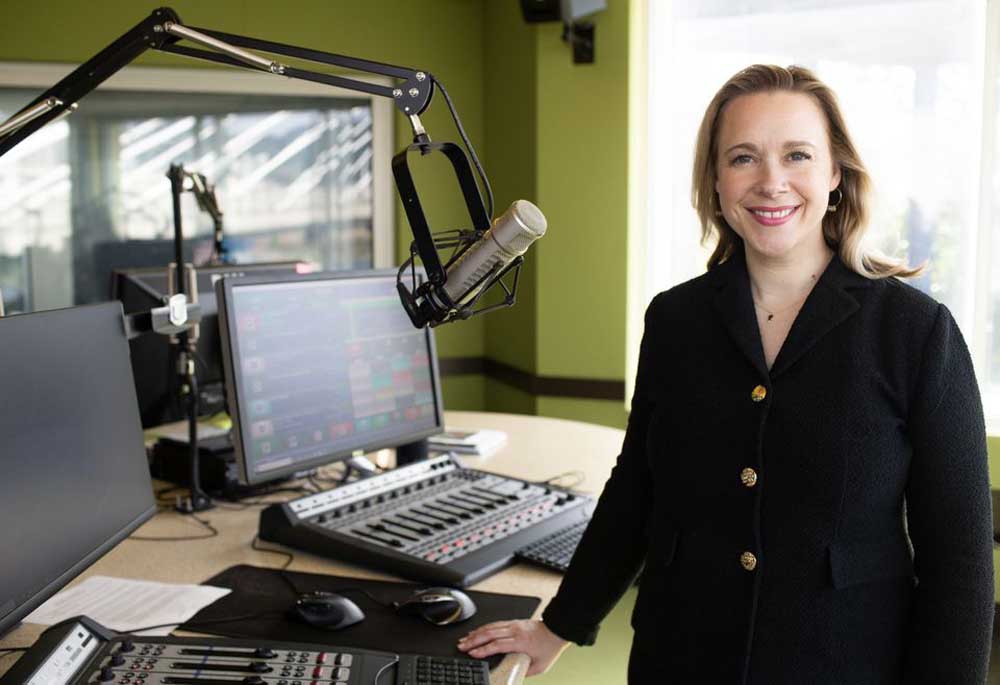Hearing the future: All Classical Radio’s move downtown is a game changer
Published 10:17 am Thursday, December 19, 2024

- Suzanne Nance, president and CEO of All Classical Radio, at the station’s headquarters.
Downtown Portland has been derided by numerous naysayers in regard to its livability and viability for the future, with some proclaiming that the city has become an “Urban Doom Loop.” But not all have succumbed to that negative message. All Classical Radio (KQAC 89.9 FM), Portland’s international broadcaster of classical music, has relocated to the heart of the city, settling into a versatile, ultra-modern top-notch headquarters that is jaw-dropping optically and technologically.
“We have a strong belief in the core of the city,” said President and CEO Suzanne Nance. “We especially want to support our local art organizations that are based downtown. Time after time, we have seen how the arts have regenerated communities across the nation. Since we outgrew our space at the Hampton Opera Center on the Eastside, it made sense to find a new home. So we looked and found the perfect place at KOIN Tower.”
Bursting at the seams with more than 12,000 members, All Classical Radio is making the most of its new digs. Its space on the third floor of KOIN Town – near where the multiplex cinema used to be – has 15,000 square feet – 3,000 more than its previous home. It also boasts state-of-the-art equipment for its recording and broadcasting studios and a 100-seat performance hall that is drop-dead gorgeous.
“In our former building we had 16 miles of wiring,” said Nance. “Now we have 30 miles. It goes all the way to the top of KOIN Tower and back down. We have an unobstructed line of sight between our antenna and our broadcast towers in hills on Portland’s Westside. We also have optimal equipment placement for performance and regular maintenance, and we have enough power because KOIN is a broadcaster is in the building. That allows us to scale up to where we need to be.”
Working with GBD Architects and Howard S. Wright Construction, All Classical Radio has a customized floor plan with offices, cubicles, and recording studios that are just the right size for its 28-member staff. Everything has been acoustically tailored by Tom Cooley of Listen Acoustics, a Portland-based firm that has designed acoustics for many performing arts centers, including Artists Repertory Theatre, Nike Corporate Theater, and Newport Performing Arts Theater.
The move downtown wasn’t cheap. Everything was taken down to the studs and rebuilt. Nance estimates that the total cost will come to $11.5 million, and the goal is within sight.
“We have raised almost $9 million in less than two years,” she said. “Gratitude! It’s the community and their belief in our service. We are especially grateful, and we’ve been creative and strategic at every part of the process.”
Now the station has more room to develop content for its classical programming a 24-hour operation that includes streaming worldwide over the internet. In addition to the recording studios, All Classical Radio also has a large production studio that is acoustically sealed off from everything else around it. Nance and company intend to add a studio piano to that space for podcasts and rehearsals.
The main broadcasting booth looks like command central with the latest and greatest equipment, including a console that can cue up anything from the station’s 35,000 track-digital library. Even though the host and co-host sit opposite each other, the setup allows them see the same broadcasting information at the same time. “It’s a game changer,” said program host Brandi Parisi. “It allows interaction in real time, which is just incredible.”
In addition to broadcasting classical music and creating its own programs such as Club Mod, Played in Oregon, The Score, and Sunday Brunch, All Classical Radio creates content that it broadcasts over its International Children’s Arts Network (ICAN). Focused on kids, families, and educators, ICAN is the only of its kind in the nation, and station’s Moonflower Studio is dedicated to that effort.
When visitors enter the lobby, they will can view the broadcasting booth that is placed directly ahead and hear what’s being played. Off one side is a floor-to-ceiling wall of CDs and the nearby breakroom area called the Artists Café, which is a short distance from the Artists Lounge.
But topping off the entire space is the Irving Levin Performance Hall, which will be able to seat up to 100 listeners. The hall is equipped with a 16 x 9 foot LED screen that will accommodate multimedia shows.
“A lot of performances have a visual element,” said Nance. “We can do video. We have five cameras and proper lighting grid. We can also do link ups to BBC for example or Zoom meetings for corporations or other organizations that want to rent the space.”
Connected to the performance hall is the James DePreist Recording Studio with state-of-the-art equipment. Both the hall and the recording studio will open more opportunities for artists to perform and record.
“Part of our vision to be a comprehensive arts and culture network,” said Nance with a beaming smile. “We are positioned to become a hub for artists and usher in a new era for Portland and beyond. The future is looking really grand.”






